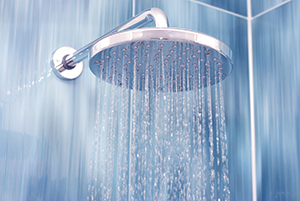Whilst you may have a specific interior lead idea as to the exact taps that you want to include in your bathroom, it’s important to remember that not all taps on the market will work in your home. Water pressure plays a huge role in the efficiency of your taps, and ensuring you understand both what kind of water pressure your home has, and which brassware will work inline with this, is important.
So, what is water pressure?
The basic principle of water pressure is a simple one, pressure is measured in “bars” and one “bar” is the equivalent to the force required to push water up to the height of 10 metres.
How does water pressure change in the home?
Water will enter our home through the cold mains under some form of pressure. Your mains water pressure will depend on where your home lies in relation to the nearest water supply, meaning that if you live at the bottom of a hill, your pressure is likely to be stronger than that of your higher counterpart. When the water enters your home at the mains, if you have a combination boiler, the water will then be heated, and if you have a gravity system, the water will be stored in a tank, and heated as required. If you’re in a newer build, there’s a possibility that you will have unvented mains, all of which require different taps, dependent on the exact pressure you have.
Cold water tank in the loft and hot water cylinder somewhere else in the home
If your system is a combination of a cold water and a hot water tank, you almost definitely have a gravity system. Chances are, this means you’ll need to choose taps that are designed to work specifically with low pressure water, as any other form of tap would be incompatible.
Combination Boiler
If your system is a sole combi boiler, chances are your boiler is wall mounted and you won’t have either a cold or hot water tank. The way in which combination boilers work is that they are fed  directly with cold, pressured water from the mains, and are heated up and pumped round in quick succession, meaning they lose very little pressure in the process. If you have a high-pressure system, you’re pretty lucky, as these systems are compatible with most taps.
directly with cold, pressured water from the mains, and are heated up and pumped round in quick succession, meaning they lose very little pressure in the process. If you have a high-pressure system, you’re pretty lucky, as these systems are compatible with most taps.
Hot water tank but no cold-water tank
Having a hot water tank but no cold-water tank means you have an unvented water system. Whilst water is stored in a tank, the tank itself is strengthened and can support keeping the water at a constant pressure and is heated as necessary. This set up is generally found in more modern new builds and provides water pressure that is suitable for most brassware.
Having a round about idea on your water pressure is important when selecting taps, but if you have a gravity system, it’s probably wise to find out your exact pressure before purchasing. If you don’t have a gauge, there is a simple and effective way to measure water pressure in your home.
Using a jug of water and a stopwatch, place your jug under the tap of choice, and turn it on. Time 6 seconds, and then measure the amount of water that’s in the jug at this specific point. At this point, you’re going to need to calculate the amount of water in the jug (in litres) multiplied by 10, to get your flow rate in litres per minute. If you’re flow rate is less than 10 litres per minute, you have low hose in the middle at 10-15 have average pressure, and those with 15 litres per minute and above have good water pressure.
For more information on which taps are right for your bathroom, Better Bathrooms are on hand to solicit advice, product information and styling tips.

Add new comment